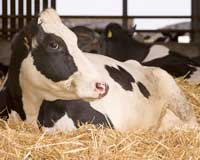Maximising feed efficiency hot topic at Semex conference

Maximising feed efficiency, dry cow management and minimising group movements were just some of the topics up for discussion at this week’s Semex conference, Glasgow.
Producers should ask themselves if it really is cost-effective to feed a different ration to high- and low-yielding cows, according to Alex Bach, head of ruminant production at IRTA, Spain.
Speaking to delegates, Dr Bach said apparent savings in feed costs from feeding a lower value ration could be overcome by losses in milk production caused when cows moved groups.
“When a cow moves from the high-yielding group to the low group she will lose 1.2 litres a day – farmers need to monitor whether making two rations is actually profitable.”
 It is widely recognised that moving cows in groups of three or five is best practice to reduce stress, but trial work has demonstrated the act of moving can have long-lasting effects.
It is widely recognised that moving cows in groups of three or five is best practice to reduce stress, but trial work has demonstrated the act of moving can have long-lasting effects.
“We undertook a trial moving cows in groups of five into pens that had the same ration and tracked activity five weeks prior to movement and four weeks after.
“Surprisingly, activity remained significantly higher four weeks after movement, with cows doing 50 steps an hour more than prior to movement.” An additional 10% of energy is needed for this kind of activity, and is thus prevented from going into milk.
Lying times were also significantly reduced, with cows lying for less than ten hours a day four weeks after they were moved versus 10.5 hours before. “This will increase the chance of lameness problems, meaning pen movements should be kept to a minimum.”
And in a separate study, stage of lactation also affected lying times, with cows demonstrating a marked decrease in lying time post calving over heifers.
Post calving, heifer milk yields increased to a peak of 40kg. Production then decreased, but lying times continued to rise throughout. However, cows actually reduced their lying times between calving and peak lactation at 55kg. After this peak, lying times increased.
“Pre-peak, cows were lying an average 650 minutes a day, then as they moved towards peak lactation, they lay less and less, losing 1.5 hours of lying time. This is due to the fact they are prioritising eating over lying,” Dr Bach explained.
“We need to try and limit this reduction in lying. Further research is needed to find out how.”
FEED AT TRANSITION
Supplying the correct amount of dietary energy to the transition cow has long been a topic for discussion, but according to Dr Bach, current thinking may not be correct.
“25% of dairy cows are culled in the first two months of calving, largely as a result of poor nutrition in the transission period. To avoid this, feeding a higher energy ration close to calving has been recommended to avoid weight lost post calving,” he said.
“However, data shows this strategy has failed to reduce the level of ketosis – in fact, high energy diets fed to close-up cows can have a negative effect on DAs and ketosis.”
The pre-partum cow needs 15Mcal a day, however, the cow is not good at regulating her intakes, meaning she will likely consume 20kg DM of a 1.6MCal/kg diet, when you want her to eat 9.4kg.
“Cows on this ‘hot’, close-up ration have more fat in the liver and higher ketones in the blood. We thought there was correlation between how much a cow eats before calving and after calving, but this is not true,” said Dr Bach
In a trial looking at three different transition diets, cows on a high-energy ration, close to calving, reduced their intakes prior to calving and maintained low intakes post calving.
Those on a high-forage, low-energy diet saw a low drop pre-calving, with reasonable intakes post calving.
Interestingly, intakes shot up dramatically after calving for animals fed on a restricted diet of 9kg of feed prior to calving.
“This means the dairy farmer can keep all his dry cows on the same low-energy TMR diet all the way through, reducing costs,” said Dr Bach.
AGE AT FIRST CALVING
Producers could be shooting themselves in the foot in terms of production and profitability, simply by not addressing age at first calving and feed management, according to Spanish trial work.
A study looking at 65 herds, totalling 3129 lactating cows, demonstrated huge variability in milk yields, despite being fed identical rations.
“Some herds produced 20kg a cow a day, while others achieved 34kg a cow a day,” said Dr Bach.
And with feed contributing 50% of total costs, removing farm “bottle necks” that are responsible for such variability is key to profitability. In fact, age at first calving has been shown to have a marked effect on first lactation milk yields.
“Among the farms trialled, average breeding age was 16.9 months – this should be at least 15 months when aiming to calve at 24 months,” he said.
Average age at first calving was actually 27.7 months, with data strongly showing age at first calving was negatively correlated with subsequent yields.
“Those calving at 32 months produced an average 26kg a cow a day, versus 32kg a cow a day for those calving at 25 months.”
Feed trough management also had a marked effect on feed use efficiency on these farms, with farmers that pushed up feed being rewarded with more milk.
“Those that pushed up feed saw yields of 29kg a cow a day versus 24-25kg a cow for farms that did not. However, there was no difference between the number of times feed was pushed up and production.”
The increase in yield was thus a result of improved feed availability, rather than a result of the act of pushing up itself being a stimulus for dry matter intakes.
Farms that fed so there were no feed leftovers also had reduced yields at an average 27.5kg a cow a day compared to 29kg a cow a day on farms that allowed for some feed wastage.
